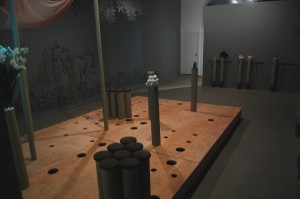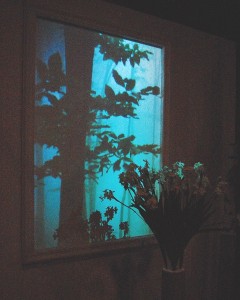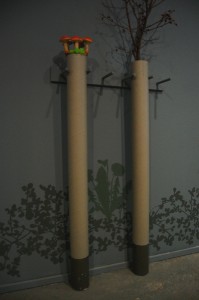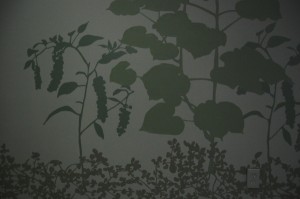April Fool’s jokes aside, the installation Common Place, which opened on April 1 at Extra Extra, is as thoughtful as it is playful. It’s an ambitious experiment in the social and the private, as well as the natural and the synthetic. It is the joint brainchild of three artists: Beth Brandon, Samantha Margherita, and Luren Jenison, who came together after noting similar themes in each others’ work.

The wooden platform that dominates the center of the gallery space is initially quite puzzling. Its surface is bored with circular holes, and rising from the far end is a wall. In the middle of the wall is a video projection, which mimics the view from a window. Outside, the leaves and branches of a tree sway in an unfelt wind. This subtle motion is the only movement in the installation, and there is no sound.

Propped up against the walls of the room itself are round tubes topped with a variety of natural and natural-looking forms: red-capped mushrooms, small bones, a log, moss, stones, and feathers, among others. After reading the near-essential artists’ statement, it becomes clear that the installation is interactive. The round pieces fit snugly into the holes, and the puzzling nature of the platform opens a realm of new questions with the realization that it is, in fact, somewhat of a puzzle.

Engaging the installation in the room allows for an investigation of how we construct our personal spaces. When we decorate the rooms of a house, there are many factors at play. Some things are necessities and others provide us with comfort. Our aesthetic choices may be personal but they also project our sensibilities and values to others. The way we arrange the pieces in the installation is both an internal decision and an outward manifestation, bridging the gap between thought and action, the individual and the social.
Along the walls are also silhouettes of local plants, most recently viewed as weeds in our urban landscape. Formerly many of them had value as medicinal plants, but now they are deemed intrusive. Beth Brandon, who I spoke with at the exhibition, explained that this reevaluation of particular plants as weeds is because these plants are so hearty.
This change in attitude is akin to our contemporary changes in lifestyle. We are removed from the production and origin of much that we use on a daily basis. We consume fruit from the tropics alongside locally grown produce. Homes are no longer constructed from stone and wood, but drywall and brick.

The installation is in many ways similar to the idea of a park. Parks are intentionally constructed mimics of nature, designed with social and personal activities in mind. They are a place to get away, as well as a place to meet others. Common Place, however, emphasizes a certain type of honesty to our existence. Everything we have is ultimately a product of the earth. It would do us well to gain insight as to where our possessions and surroundings originate, and with this knowledge, to learn to use our resources more wisely.









